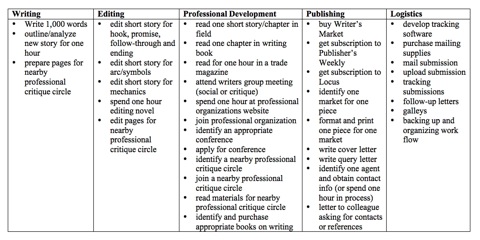Goal Achievement: The Nibbled to Death by Ducks Methodology
However, almost universally, the students struggled with converting their dreams into reality. I came to the sad realization that teenagers don’t change their personal goals more often than their underwear only because they are experimenting and trying on new persona. Sometimes, they change because their goals seem too large, too unobtainable and they reset their sights on something easier, closer. They do so because no one has shown them how to achieve the goals they set.
In the U. S., we have a bad habit of telling every kid that they can be anything they want to be. Then, we keep the “how” to ourselves because we really don’t want the competition. Over the years and in my own act of subversion, I developed an integrated method to help students identify, achieve and advance their personal goals. In so doing, I used myself as a guinea pig and still use the method today. To demonstrate this, I will use my new personal goal of moving from being a non-fiction to a fiction writer. As I explain on my About page, I no longer wish to talk about what is, but rather, what if.
I do not have a cute acronym. I simply call the method Nibbled to Death by Ducks. (Or cats… if you are Londo Mollari.) The point is to identify the “actionable” parts of the goal and do the minimum each day to get there, one brick at a time. You do need to see the big picture to know where you are heading but how you get there is by attacking the minutia. The method is very simple. I will outline it below and then discuss each section separately.
- List your goals on a piece of paper and pick one. If you need help on selecting a personal goal, here is an essay that might help. (Warning for males… the essay is written by a contributor to O magazine Martha Beck and will require that you download it from Oprah’s website. You might want to wear rubber gloves when you click the mouse and erase your browser’s history lest you contract a case of girl cooties or suffer a precipitous drop in testosterone.) For me, I would write, “Career change to fiction writer.”
- Brain storm and then mind map all aspects, requirements, etc. of that goal.
- Plan backwards and fill out the map and/or develop some action plans if you are a linear thinker.
- Develop a list of minimum effective things you can do in less than an hour.
- Keep a record of progress.
- Rinse and repeat. (If your goal is to be some type of writer, you will need to write, edit, submit, proof and market innumerable times. Especially, the submit part…)
Mind-mapping, A.K.A. concept mapping, is a way of organizing, linking and integrating disparate pieces of information into a cohesive whole. Here are two examples.

Sample concept map demonstrating linkages, color coding and the use of shapes to highlight hierarchy. Click here for a larger version.
Sample concept map drawn by hand.
The point of making a mind map is to help organize ideas and thoughts and identify relationships. Additionally, mind maps help keep track of tasks completed and those left to do. A mind map starts with a main idea or goal in the center with the secondary ideas branching off. You organize these ideas into pictures linked by physical proximity, colors, shapes, icons, lines and arrows.
You can make a mind map the old fashioned way with a few Sharpies and really big stickie note or by using a mind-mapping software such as Freemind. Freemind is a free java-based software that is compatible with all platforms including mac, several flavors of PC and linux. I have used both techniques. I like the physical nature of the paper and a pile of Sharpies but if I need to share my map with others, or if it is particularly large or complex, I use software. The advantages beyond legibility include the use of icons, sorting, using color clouds, etc. Other software that I like and have used in the past include Curio, Tinderbox and Omnigraffle. Note that this class of software is very useful for writers to plot out characters and their relationships. However, I will limit the discussion today to goal setting and achievement using my own personal goal of moving from a non-fiction to fiction writer.
The link to the actual Freemind file for my writing goal is here. You may download it and modify it as you see fit. For those who do not wish to use Freemind but would like to follow along, the pdf export of this file is below.

Career as Fiction Writer Mind Map Example. Click here for the pdf version.
Making a mind map is easy. Write down your goal is as few words as possible and put that in the center. Brain storm all the key ideas, hurdles, requirements, supports, etc. and distribute them around the central idea. Feel free to use shapes, colors and distance from the center to imply additional information. Link the ideas via lines or arrows. For my writing goal the main topics include: writing, submitting, publishing, professional development, professional organizations and support network. Fill in the details making the map as “bushy” as possible. Now use the map to identify areas where you are weak, to remind you of what needs to be done and to keep track of your progress.
How do you make that mind map “bushy?” How do you get everything listed that really needs to be listed? You use the technique of backwards planning. You can do a Google search and find about 3,770,000 results in 0.29 seconds but the quickie definition is that you look at the goal first, “Career as Fiction Writer.” You start there. At the end. Now, ask yourself what has to happen immediately BEFORE to arrive at that goal? Write that event down. Now, what has to happen immediately before THAT? List all those steps back up to the main concepts in your mind map.
Taking my writing goal as an example, if you define a fiction writer as someone who writes fiction, then the action immediately before has to be to write a piece of fiction. If you define fiction writer as a PUBLISHED fiction writer then the immediate step before is OKing the proofs. The thing before that is responding to the copy editor. The thing before that is turning in the revised version. The thing before that is getting the editor’s comments. The thing before that is signing the contract. The thing before that is getting a contract. The thing before that is… It’s quite the trip back to the initial writing part.
This is where a lot of students get lost. They can’t get from where they are to where they want to be because they are convinced they don’t know how. But, if they plan backward, they realize that there is not all that much research to be done and that it is entirely doable. They also get a grip on a realistic timeline. My educated guess (having written buckets of non-fiction) is that it will take me two years to convert to being a fiction author as defined by publication.
For those interested in learning more about developing realistic timelines via backward planning, I suggest Wishcraft by Barbara Sher. It is a 30-year old book that is still in print. You can download the free pdf version here. However, if you are like me, you will want a paper copy.
If you are a big picture person, filling out the mind map using backward planning might be all you need. As you complete things on your mind map, you add icons or smaller post-its if you are using paper. However, most people suffer a severe case of bipolar disorder when they sit back and examine their mind map. You are happy and feel pleased with your accomplishment because you have a goal and a map in front of you. Congrats! And then… bam! You realize that you have a million things to do and, holy guano batman, you’d better duck back into the cave, eat a pint of Ben and Jerry’s and retune the bat antenna to HBO for the rest of your life. Zowie!
So… How do you take that now absurdly HUGE map and achieve that goal? I suggest using the minimum effective action trick. You list at least ten of the absolute smallest single things you can do to move toward your goal and do ONE. That’s it, only one. Your inner critic, your personal resistance monster, has a hard time getting up in arms over such a small thing. Before you go to bed, you pick another and do that the next day. When your list runs short and you have crossed 7-8 off, then you come up with another ten. Eventually, you will run out of things to put down because you have in fact, achieved your goal.
Sounds new-agey to you? Well, we have been doing this for 38,000+ years. Yep. In the caves of Lascaux, there are paintings of several animal hunts.

Photo credit: http://deitchman.com/mcneillslides/units.php?unit=%20Prehistoric%20Arts
The pictures depict the goal (not starving or freezing to death), the skinning and butchering, the animals hit with spears and arrows, the hunt, the practicing with the weapons and finally the making of the weapons. You could argue that I am reading the pictures in the wrong order. That it is forward planning. Well, modern languages read both from left to right and right to left. My interpretation is just as valid.
Taking this example, what are some minimum effective actions our cavemen could take? Find a nice pointy stick. Find a nice rock. Chip the rock I found yesterday.
Now, what about writing? Looking at the map above, there are thousands of minimum effective actions I could take. I will use the development of this website as the example.
- Goal: Find and communicate with like-minded people for mutual support.
- Major Branch off that goal: Have a website.
- Backward Planning: Develop comment page, provide way so people can comment, have content to comment on, upload site to host, obtain site host, do homework on hosts, make website, learn how to use software, obtain software, do homework on software available, think about what I want the site to be like
- Minimum Effective Action: (1) go online and find three hosts; (2) compare prices between hosts; (3) ask friends which software they use to build sites; (4) check out Wordpress to see if that would be easier; (5) download sample software; (6) play with software; (7) play with a different piece of software; (8) pick a piece of software; (9) learn how to make a comment page; (10) make a comment page… and so on.
As a final illustration of minimum effective actions vis à vis writing, here is another list I made that spans the mind map. Perhaps, some of these will inspire you.

Click here for a .doc version of this example of minimum effective actions for fiction writers.
The last thing to do is to keep track of all these small actions. They do add up and when you are depressed as all hell, then you can see explicitly and graphically that you have indeed made progress.
Does this work? One former student is now the tattoo artist she always wanted to be. Another is a state legislator (can’t save’em all) and another has a position at Argonne National lab. As for me, using this method, I moved from teaching high school to pursuing my Ph.D., to obtaining a tenure track position and then tenure. But… your mileage might vary. Good Luck!



